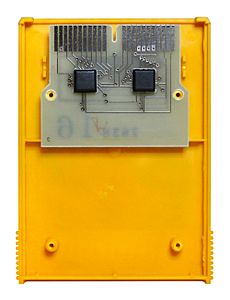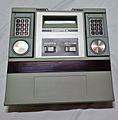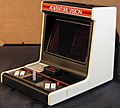Second generation of video game consoles facts for kids
Get ready to travel back in time to the exciting early days of video games! The second generation of video games covers consoles and handhelds that were popular from 1976 to 1992. This era saw some really famous game systems like the Fairchild Channel F, Atari 2600, Intellivision, Odyssey 2, and ColecoVision.
It all kicked off in November 1976 with the Fairchild Channel F. Then came the super popular Atari 2600 in 1977. Many other consoles followed, and by the end of this period, there were over 15 different systems! This time was also known as the "golden age of arcade video games" because arcades were so popular. Many games you played at home were versions of those cool arcade hits. For example, Space Invaders, a huge arcade game, came to the Atari 2600 in 1980.
Unlike the very first game consoles that had games built right in, the second generation mostly used special game cartridges. These cartridges held the entire game, making it easy to swap games and play different adventures. The Fairchild Channel F was the first console to use a special computer chip called a microprocessor, which made these cartridges possible. Over time, things like graphics, colors, sound, and even how smart the computer players were (AI) got much better. This era also brought us the first handheld game system that used cartridges, called the Microvision, released in 1979.
In 1979, a company called Activision was started by former Atari programmers. They were the first "third-party" company to make games for other companies' consoles. But by 1982, there were too many consoles and games, and some of them weren't very good. This led to a big problem called the video game crash of 1983. Many game companies struggled, and not many new games came out in 1984. The video game world didn't fully recover until the next generation of consoles began. The second generation officially ended on January 1, 1992, when the Atari 2600 was finally stopped being made.
Contents
How Video Games Changed

A huge reason the second generation of consoles was so different was the invention of the affordable microprocessor. Before this, game consoles used many different electronic parts, and each game was built into the machine itself. Imagine if your game console could only play one game forever! That's how it was for the very first consoles.
Companies like Atari realized that making a whole new machine for every single game was too expensive and took too long. They needed a way to make one console that could play many different games. That's where the microprocessor came in. This special computer chip could follow instructions, allowing game makers to create software programs that could be changed.
Engineers at companies like Alpex Computer Corporation and Atari saw that these microprocessors could be used in home consoles. This led to the Fairchild Channel F, released in 1976. It was the first home console to use a microprocessor and also the first to use ROM cartridges. These cartridges were like small plastic boxes holding a computer chip with the game's software. You could just pop them into the console! Atari's famous Atari Video Computer System (later known as the Atari 2600) came out in 1977 and also used cartridges. Soon, other console makers followed this new trend.
At first, console companies made all their own games. But in 1979, four former Atari programmers started their own company, Activision. They wanted to make their own games for the Atari VCS, like Kaboom! and Pitfall!. Atari wasn't happy at first, but they eventually agreed that Activision could make games for their console if they paid a small fee. This was a big deal! It meant other companies could now make games for consoles, leading to many more games being released.
This era also happened at the same time as the "golden age" of arcade games. So, it became very popular for console makers to get licenses to bring popular arcade games home. Many of these came from Japanese companies, and some people even predicted that Japanese companies would become very important in the video game world.
This new way of selling games also led to a business idea called the "razorblade model." It's like how a razor handle is cheap, but the blades are where the company makes money. Console companies started selling their consoles for a low price, sometimes even losing money on them. But they made their profits from selling the game cartridges and from fees paid by third-party game makers.
Popular Home Consoles
There were many home consoles during this time. Here are some of the most famous ones:
Fairchild Channel F
The Fairchild Channel F was released in November 1976. It was the very first console to use a CPU (the "brain" of a computer) and game cartridges. It even had a pause button, which was a big deal back then! This meant you could stop your game without turning off the console and losing your progress. The console came with two games, Hockey and Tennis, and Fairchild released 26 more cartridges.
However, when the Atari 2600 came out with more action-packed games, the Channel F's popularity quickly faded. Fairchild tried to update it with the Channel F System II, but it was too late. The Atari 2600 had already taken over the market.
Atari 2600 and 5200

The Atari 2600, originally called the Video Computer System (VCS), came out in 1977. It launched with nine games just in time for the holidays. Atari had special deals to turn many popular arcade games into home versions, which helped them sell a lot of consoles. Even though other consoles later had better graphics, the Atari 2600 was cheaper and had more popular games. It sold over 30 million units, making it the best-selling console of its generation by far!
In 1982, Atari released the Atari 5200 to try and compete with consoles like the Intellivision. It was better than the 2600, but it didn't sell well and didn't get many new games. Atari stopped supporting it after only two years.
Atari 2600 game cartridges started small, holding about 2 kilobytes of game data. But they grew over time, using a special trick called "bank switching" to fit more game information. Some later games even had extra computer memory (RAM) right inside the cartridge! The classic Atari 2600 joystick had just one button and was released in 1977.
Bally Astrocade
The Bally Astrocade was released in 1977. It was first sold by mail order and then in computer stores. It didn't get as much attention as the Atari VCS. The console changed hands and names a few times, eventually being called the Astrocade. It was discontinued during the video game crash of 1983.
In 1978, Magnavox released its own microprocessor-based console, the Odyssey 2. In Europe, it was known as the Philips G7000. A cool feature of this system was an add-on that could make speech sounds, music, and sound effects even better. Some Odyssey 2 games even came with a game board and pieces, mixing video games with board games! While it wasn't as popular as the Atari consoles, it sold 2 million units, making it the third best-selling console of its time. It was stopped being made in 1984.
Intellivision
Mattel introduced the Intellivision in 1979. It was quite advanced for its time, with a 16-bit processor and a special sound chip that could make sounds on three different channels. It was also the first console to have a thumb-pad controller for movement and games that could scroll vertically and horizontally.
The Intellivision was the first home console to use a 16-bit microprocessor and even offered a way to download games through a service called PlayCable! It could also play real human voices during gameplay. This console was the first serious competitor to Atari's dominance. Mattel even ran TV ads showing how its graphics and sound were better than the Atari 2600. It sold over 3 million units before being discontinued in 1990.
ColecoVision
The ColecoVision was released by toy maker Coleco in August 1982. It was more powerful than many earlier consoles and offered a gaming experience that felt much closer to the arcade games. It launched with popular arcade games like Sega's Zaxxon. A unique feature was an expansion module that let you play Atari 2600 games on the ColecoVision! This even led to a lawsuit from Atari. Sadly, the ColecoVision was also affected by the video game crash and was stopped being made in 1985.
Vectrex
The Vectrex came out in 1982 and was very special because it had its own built-in screen! It used "vector graphics," which drew images using lines instead of pixels, like many popular arcade games of the time. It had a strong library of games, including arcade hits like Space Wars. Even though it was unique and well-liked, the Vectrex didn't sell well and was only on the market for less than two years.
Top Selling Consoles
Here are the sales numbers for some of the most popular consoles of this generation:
| Console | Units sold worldwide |
|---|---|
| Atari 2600 | 30 million |
| Intellivision | 3 million |
| ColecoVision | 2 million |
| Magnavox Odyssey² | 2 million |
| Atari 5200 | 1 million |
| Fairchild Channel F | 350,000 |
| Bally Astrocade | Unknown |
| Emerson Arcadia 2001 | Unknown |
| Vectrex | Unknown |
Other Cool Consoles
-
RCA Studio II (1977)
-
APF-MP1000 (1978)
-
Epoch Cassette Vision (1981)
Handheld Systems
This generation also saw the rise of handheld gaming!
Microvision
The Microvision, made by Milton Bradley, came out in 1979. It was the very first handheld game console where you could swap out game cartridges! Each cartridge even had its own processor, as the console itself didn't have one. It had a small library of games, but it was known for being easily damaged by static electricity, and its screen could stop working. Because of these problems, it was stopped being made just two years after it came out.
Entex Select-A-Game and Adventure Vision
Entex released two handheld systems. The Select-A-Game had six games but was only available for a year. Then, Entex focused on the Adventure Vision, released in 1982. This console was very unique because it used a spinning mirror system to create its display! It was also quite big and had to be used sitting down. It was discontinued in 1983 after selling only about 50,000 units.
Palmtex Super Micro
The Super Micro, made by Palmtex, was released and discontinued in 1984. Only three games were released for it, and people said it broke easily. It sold fewer than 37,000 units.
Epoch Game Pocket Computer
The Epoch Game Pocket Computer was released in Japan in 1984. It didn't sell well, so only five games were made for it, and it was never released outside of Japan.
Nintendo Game & Watch
Nintendo's Game & Watch was a series of 60 different handheld consoles, with each one having a single game built into it. The first one, "Ball," came out in 1980, and new titles were released until 1991. Unlike other handhelds, the Game & Watch had a segmented LCD screen, like a digital watch, which meant the display was limited to pre-set shapes. This series was incredibly popular, selling a combined 43.4 million units, making it the most successful handheld of its generation!
Amazing Games of the Era
Many classic and important games came out during this time. Here are some of the most famous ones:
- Advanced Dungeons and Dragons: Cloudy Mountain (Intellivision) was a top adventure game and one of the first Intellivision games to use a lot of memory.
- Adventure (Atari 2600) was a groundbreaking game. It was one of the first action-adventure and fantasy role-playing games on a console.
- Asteroids (Atari 2600) was the first game on the 2600 to use a special memory trick called bank switching to fit more data.
- Baseball (Intellivision) was the best-selling game for the Intellivision, selling over a million copies.
- Demon Attack (Atari 2600) was a very popular game that won an award for "Best Videogame of the Year" in 1983.
- Donkey Kong (ColecoVision) was praised for being very similar to the original arcade game.
- E.T. the Extra-Terrestrial (Atari 2600) is often called one of the worst games ever made. Some people even think it played a part in the video game crash of 1983.
- Microsurgeon (Intellivision) was a very original game that was even featured in a museum exhibit about video games!
- Missile Command (Atari 2600) sold over 2.5 million copies, making it one of the top-selling games on the console.
- Pitfall! (Atari 2600) was one of the best-selling games for the Atari 2600, selling over 4 million copies. It helped make side-scrolling platformer games popular.
- Pitfall II: Lost Caverns (Atari 2600) was very advanced for the 2600, with a special sound chip in the cartridge that allowed for amazing music.
- River Raid (Atari 2600) was very popular and won an award for "Best Action Videogame."
- Space Invaders (Atari 2600) was the first official arcade game to be brought to a home console. It was so popular that Atari 2600 sales quadrupled after it came out, and it was the first game to sell 1 million copies!
- Star Wars: The Empire Strikes Back (Atari 2600) was the very first officially licensed video game based on the Star Wars movies.
- Utopia (Intellivision) is often seen as the first "real-time strategy" game, which means it helped create a whole new type of game!
- Zaxxon (ColecoVision) was the first home console game to use "isometric graphics," which made things look 3D.
Images for kids
See also
 In Spanish: Videoconsolas de segunda generación para niños
In Spanish: Videoconsolas de segunda generación para niños
- 1970s in video games
- 1980s in video games
- Third generation of video game consoles
- First generation of video game consoles
- Home computer (List of home computers)
- History of computing hardware (1960s–present)



























